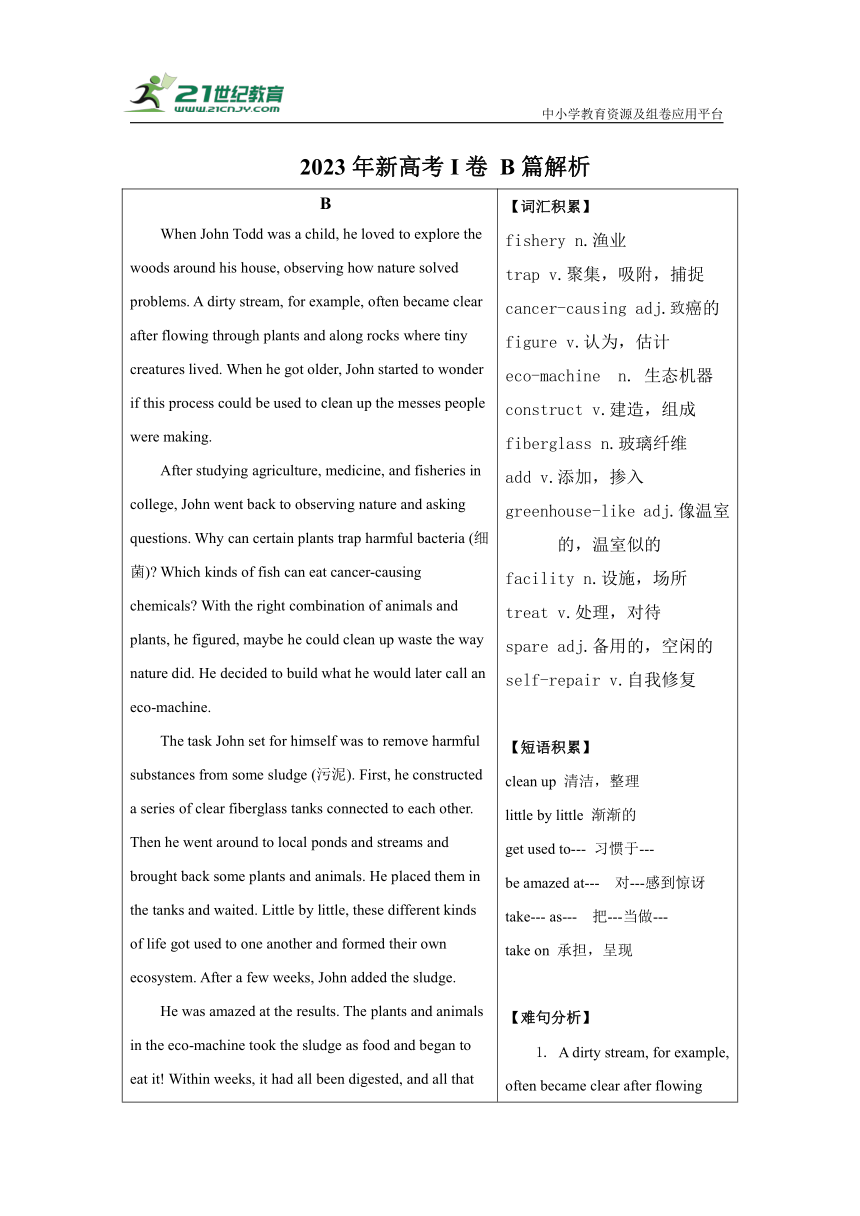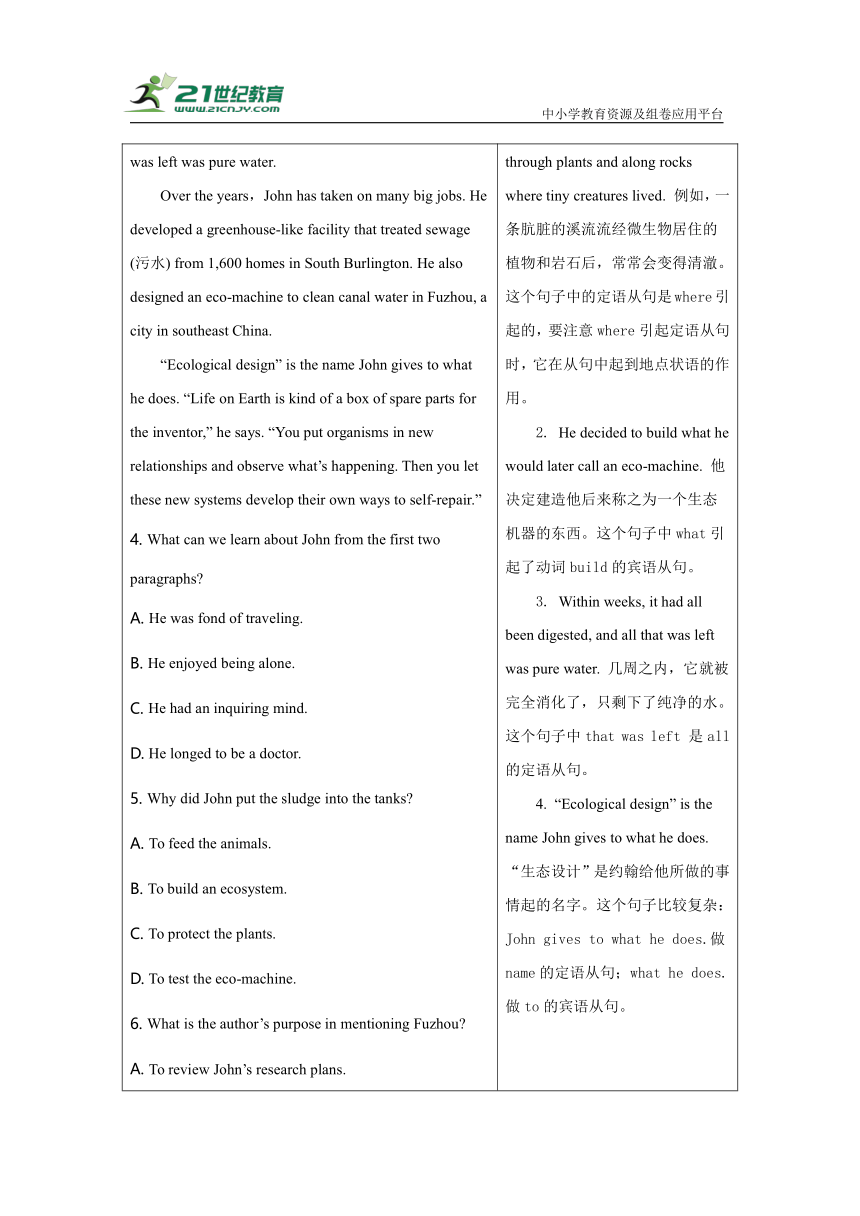2023年高考英语真题(新高考I卷)阅读理解B篇 解读分析 学案
文档属性
| 名称 | 2023年高考英语真题(新高考I卷)阅读理解B篇 解读分析 学案 |  | |
| 格式 | doc | ||
| 文件大小 | 157.2KB | ||
| 资源类型 | 试卷 | ||
| 版本资源 | 人教版(2019) | ||
| 科目 | 英语 | ||
| 更新时间 | 2023-06-22 12:27:44 | ||
图片预览


文档简介
中小学教育资源及组卷应用平台
2023年新高考I卷 B篇解析
BWhen John Todd was a child, he loved to explore the woods around his house, observing how nature solved problems. A dirty stream, for example, often became clear after flowing through plants and along rocks where tiny creatures lived. When he got older, John started to wonder if this process could be used to clean up the messes people were making.After studying agriculture, medicine, and fisheries in college, John went back to observing nature and asking questions. Why can certain plants trap harmful bacteria (细菌) Which kinds of fish can eat cancer-causing chemicals With the right combination of animals and plants, he figured, maybe he could clean up waste the way nature did. He decided to build what he would later call an eco-machine.The task John set for himself was to remove harmful substances from some sludge (污泥). First, he constructed a series of clear fiberglass tanks connected to each other. Then he went around to local ponds and streams and brought back some plants and animals. He placed them in the tanks and waited. Little by little, these different kinds of life got used to one another and formed their own ecosystem. After a few weeks, John added the sludge.He was amazed at the results. The plants and animals in the eco-machine took the sludge as food and began to eat it! Within weeks, it had all been digested, and all that was left was pure water.Over the years,John has taken on many big jobs. He developed a greenhouse-like facility that treated sewage (污水) from 1,600 homes in South Burlington. He also designed an eco-machine to clean canal water in Fuzhou, a city in southeast China.“Ecological design” is the name John gives to what he does. “Life on Earth is kind of a box of spare parts for the inventor,” he says. “You put organisms in new relationships and observe what’s happening. Then you let these new systems develop their own ways to self-repair.”4. What can we learn about John from the first two paragraphs A. He was fond of traveling.B. He enjoyed being alone.C. He had an inquiring mind.D. He longed to be a doctor.5. Why did John put the sludge into the tanks A. To feed the animals.B. To build an ecosystem.C. To protect the plants.D. To test the eco-machine.6. What is the author’s purpose in mentioning Fuzhou A. To review John’s research plans. B. To show an application of John’s idea.C. To compare John’s different jobs. D. To erase doubts about John’s invention.7. What is the basis for John’s work A. Nature can repair itself.B. Organisms need water to survive.C. Life on Earth is diverse.D. Most tiny creatures live in groups. 【词汇积累】fishery n.渔业 trap v.聚集,吸附,捕捉 cancer-causing adj.致癌的 figure v.认为,估计 eco-machine n. 生态机器construct v.建造,组成 fiberglass n.玻璃纤维 add v.添加,掺入 greenhouse-like adj.像温室的,温室似的 facility n.设施,场所 treat v.处理,对待 spare adj.备用的,空闲的 self-repair v.自我修复 【短语积累】clean up 清洁,整理 little by little 渐渐的 get used to--- 习惯于--- be amazed at--- 对---感到惊讶 take--- as--- 把---当做--- take on 承担,呈现 【难句分析】A dirty stream, for example, often became clear after flowing through plants and along rocks where tiny creatures lived. 例如,一条肮脏的溪流流经微生物居住的植物和岩石后,常常会变得清澈。这个句子中的定语从句是where引起的,要注意where引起定语从句时,它在从句中起到地点状语的作用。He decided to build what he would later call an eco-machine. 他决定建造他后来称之为一个生态机器的东西。这个句子中what引起了动词build的宾语从句。Within weeks, it had all been digested, and all that was left was pure water. 几周之内,它就被完全消化了,只剩下了纯净的水。这个句子中that was left 是all的定语从句。“Ecological design” is the name John gives to what he does. “生态设计”是约翰给他所做的事情起的名字。这个句子比较复杂:John gives to what he does.做name的定语从句;what he does.做to的宾语从句。
【应试点拨】:1. 本篇文章中出现了很多合成词,理解这些词的时候,不要试图翻译它们的确切含义,重在理解词汇来源方面的启发和暗示。 2.人物介绍类的文章一般会介绍人物的生活背景、教育、经历等,并且会着重提及他们的成就和影响,尤其对其他人的激励和启发。 3. 人物介绍类的文章一般会问及人物的性格特点或观点,要注意根据文章中的细节进行推理和判断,逻辑思维一直是考察重点,平时的阅读练习要形成这方面的习惯。 4. 平时的阅读练习要有意识的培养关注文章结构的习惯。【译文】当约翰·托德还是个孩子的时候,他喜欢探索房子周围的树林,观察大自然是如何解决问题的。例如,一条肮脏的溪流流经微生物栖息的植物和岩石后,常常变得清澈。长大后,约翰开始思考这个过程是否可以被用来清理人类造成的脏乱情况。在大学学习了农业、医学和渔业之后,约翰又回到了观察自然和提出问题的状态。为什么某些植物能捕获有害细菌 哪些鱼类会食用致癌化学物质 他认为,通过正确的动植物组合,也许他可以像大自然那样清理废物。他决定建造一个他后来称之为生态机器的东西。约翰给自己定的任务是去除一些污泥中的有害物质。首先,他建造了一系列相互连接的透明玻璃纤维水罐。然后他去了当地的池塘和溪流,带回了一些植物和动物。他把它们放在这些水罐里,等待了一段时间。渐渐地,这些不同种类的生命相互适应,形成了自己的生态系统。几个星期后,约翰把污泥加了进去。他对结果感到惊讶。生态机器里的动植物把污泥当成了食物,开始吃起来!几周之内,污泥都被消化了,剩下的就只是是纯净的水了。这些年来,约翰承担了许多重大工作。他开发了一个类似温室的设施,可以处理来自南伯灵顿1600户家庭的污水。他还设计了一种生态机器来清洁中国东南部城市福州的运河水。“生态设计”是约翰给他所做的事情起的名字。 “地球上的生命就像是发明家的一箱备用零件。”他说,“你把生物体放在新的关系中,观察会发生什么。然后你让这些新系统自行发展自我修复的方式。” 【答案】4. C 5. D 6. B 7. A【解析】这是一篇人物介绍类的文章。文章讲述了John Todd从小就很爱思考且好学,他建造了一个生态机器,利用自然可以自我修复的原理来净化污水。【4题详解】细节理解题。第一段中提及:当约翰·托德还是个孩子的时候,他观察大自然是如何解决问题的。长大后,约翰开始思考这个过程是否可以用来清理人们制造的脏乱污物。 第二段中提及:约翰为验证自己的这个思路而决心做实验。因此,我们可以推断出约翰具有爱探索的意识。故选C。【5题详解】细节理解题。根据第三段第一句,约翰的实验目的是为了能够消除一些污泥中的有害物质。然后本段就叙述了他的实验过程,在水罐中的生物形成了自己的生态系统后,他把污泥加了进去,去验证能否去除污泥中的有害物质。可知,约翰把污泥放进水罐里的目的是为了测试自己的生态机器能否去除污泥中的有害物质。故选D。【6题详解】细节理解题。根据倒数第二段第一句,这些年来,约翰承担了许多重大工作。然后提及了他的工作的两个例子,展示了他的思路的具体应用。因此,提及清洁福州运河水这个例子,就是为了展示他的思路的具体应用。故选B。【7题详解】文章结构理解题。第一段中就提及了他观察自然是如何解决问题的,然后介绍了他的实验和验证过程,以及他的思路的具体应用,最后一段中他自己又总结了自己的思路,让自然发展自我修复的方式。可知,约翰工作的基础是自然可以自我修复。故选A。
2023年新高考I卷 B篇解析
BWhen John Todd was a child, he loved to explore the woods around his house, observing how nature solved problems. A dirty stream, for example, often became clear after flowing through plants and along rocks where tiny creatures lived. When he got older, John started to wonder if this process could be used to clean up the messes people were making.After studying agriculture, medicine, and fisheries in college, John went back to observing nature and asking questions. Why can certain plants trap harmful bacteria (细菌) Which kinds of fish can eat cancer-causing chemicals With the right combination of animals and plants, he figured, maybe he could clean up waste the way nature did. He decided to build what he would later call an eco-machine.The task John set for himself was to remove harmful substances from some sludge (污泥). First, he constructed a series of clear fiberglass tanks connected to each other. Then he went around to local ponds and streams and brought back some plants and animals. He placed them in the tanks and waited. Little by little, these different kinds of life got used to one another and formed their own ecosystem. After a few weeks, John added the sludge.He was amazed at the results. The plants and animals in the eco-machine took the sludge as food and began to eat it! Within weeks, it had all been digested, and all that was left was pure water.Over the years,John has taken on many big jobs. He developed a greenhouse-like facility that treated sewage (污水) from 1,600 homes in South Burlington. He also designed an eco-machine to clean canal water in Fuzhou, a city in southeast China.“Ecological design” is the name John gives to what he does. “Life on Earth is kind of a box of spare parts for the inventor,” he says. “You put organisms in new relationships and observe what’s happening. Then you let these new systems develop their own ways to self-repair.”4. What can we learn about John from the first two paragraphs A. He was fond of traveling.B. He enjoyed being alone.C. He had an inquiring mind.D. He longed to be a doctor.5. Why did John put the sludge into the tanks A. To feed the animals.B. To build an ecosystem.C. To protect the plants.D. To test the eco-machine.6. What is the author’s purpose in mentioning Fuzhou A. To review John’s research plans. B. To show an application of John’s idea.C. To compare John’s different jobs. D. To erase doubts about John’s invention.7. What is the basis for John’s work A. Nature can repair itself.B. Organisms need water to survive.C. Life on Earth is diverse.D. Most tiny creatures live in groups. 【词汇积累】fishery n.渔业 trap v.聚集,吸附,捕捉 cancer-causing adj.致癌的 figure v.认为,估计 eco-machine n. 生态机器construct v.建造,组成 fiberglass n.玻璃纤维 add v.添加,掺入 greenhouse-like adj.像温室的,温室似的 facility n.设施,场所 treat v.处理,对待 spare adj.备用的,空闲的 self-repair v.自我修复 【短语积累】clean up 清洁,整理 little by little 渐渐的 get used to--- 习惯于--- be amazed at--- 对---感到惊讶 take--- as--- 把---当做--- take on 承担,呈现 【难句分析】A dirty stream, for example, often became clear after flowing through plants and along rocks where tiny creatures lived. 例如,一条肮脏的溪流流经微生物居住的植物和岩石后,常常会变得清澈。这个句子中的定语从句是where引起的,要注意where引起定语从句时,它在从句中起到地点状语的作用。He decided to build what he would later call an eco-machine. 他决定建造他后来称之为一个生态机器的东西。这个句子中what引起了动词build的宾语从句。Within weeks, it had all been digested, and all that was left was pure water. 几周之内,它就被完全消化了,只剩下了纯净的水。这个句子中that was left 是all的定语从句。“Ecological design” is the name John gives to what he does. “生态设计”是约翰给他所做的事情起的名字。这个句子比较复杂:John gives to what he does.做name的定语从句;what he does.做to的宾语从句。
【应试点拨】:1. 本篇文章中出现了很多合成词,理解这些词的时候,不要试图翻译它们的确切含义,重在理解词汇来源方面的启发和暗示。 2.人物介绍类的文章一般会介绍人物的生活背景、教育、经历等,并且会着重提及他们的成就和影响,尤其对其他人的激励和启发。 3. 人物介绍类的文章一般会问及人物的性格特点或观点,要注意根据文章中的细节进行推理和判断,逻辑思维一直是考察重点,平时的阅读练习要形成这方面的习惯。 4. 平时的阅读练习要有意识的培养关注文章结构的习惯。【译文】当约翰·托德还是个孩子的时候,他喜欢探索房子周围的树林,观察大自然是如何解决问题的。例如,一条肮脏的溪流流经微生物栖息的植物和岩石后,常常变得清澈。长大后,约翰开始思考这个过程是否可以被用来清理人类造成的脏乱情况。在大学学习了农业、医学和渔业之后,约翰又回到了观察自然和提出问题的状态。为什么某些植物能捕获有害细菌 哪些鱼类会食用致癌化学物质 他认为,通过正确的动植物组合,也许他可以像大自然那样清理废物。他决定建造一个他后来称之为生态机器的东西。约翰给自己定的任务是去除一些污泥中的有害物质。首先,他建造了一系列相互连接的透明玻璃纤维水罐。然后他去了当地的池塘和溪流,带回了一些植物和动物。他把它们放在这些水罐里,等待了一段时间。渐渐地,这些不同种类的生命相互适应,形成了自己的生态系统。几个星期后,约翰把污泥加了进去。他对结果感到惊讶。生态机器里的动植物把污泥当成了食物,开始吃起来!几周之内,污泥都被消化了,剩下的就只是是纯净的水了。这些年来,约翰承担了许多重大工作。他开发了一个类似温室的设施,可以处理来自南伯灵顿1600户家庭的污水。他还设计了一种生态机器来清洁中国东南部城市福州的运河水。“生态设计”是约翰给他所做的事情起的名字。 “地球上的生命就像是发明家的一箱备用零件。”他说,“你把生物体放在新的关系中,观察会发生什么。然后你让这些新系统自行发展自我修复的方式。” 【答案】4. C 5. D 6. B 7. A【解析】这是一篇人物介绍类的文章。文章讲述了John Todd从小就很爱思考且好学,他建造了一个生态机器,利用自然可以自我修复的原理来净化污水。【4题详解】细节理解题。第一段中提及:当约翰·托德还是个孩子的时候,他观察大自然是如何解决问题的。长大后,约翰开始思考这个过程是否可以用来清理人们制造的脏乱污物。 第二段中提及:约翰为验证自己的这个思路而决心做实验。因此,我们可以推断出约翰具有爱探索的意识。故选C。【5题详解】细节理解题。根据第三段第一句,约翰的实验目的是为了能够消除一些污泥中的有害物质。然后本段就叙述了他的实验过程,在水罐中的生物形成了自己的生态系统后,他把污泥加了进去,去验证能否去除污泥中的有害物质。可知,约翰把污泥放进水罐里的目的是为了测试自己的生态机器能否去除污泥中的有害物质。故选D。【6题详解】细节理解题。根据倒数第二段第一句,这些年来,约翰承担了许多重大工作。然后提及了他的工作的两个例子,展示了他的思路的具体应用。因此,提及清洁福州运河水这个例子,就是为了展示他的思路的具体应用。故选B。【7题详解】文章结构理解题。第一段中就提及了他观察自然是如何解决问题的,然后介绍了他的实验和验证过程,以及他的思路的具体应用,最后一段中他自己又总结了自己的思路,让自然发展自我修复的方式。可知,约翰工作的基础是自然可以自我修复。故选A。
同课章节目录
